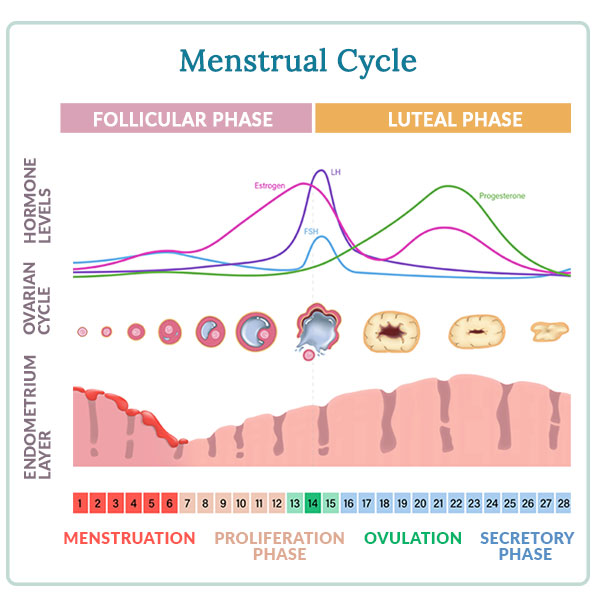Authored by Dr. Sarika Arora, MD
When I talk about the benefits of our periods, many women roll their eyes, some laugh and others cry. While there are plenty of things I don’t love about my period, not everything about your period is negative!
The benefit of your menstrual cycle is its ability to help you learn, plan for and make choices about your individual health, mood, exercise — and naturally, your sex life.

What’s more, regular menstrual periods tell you that your hormones are in balance — critical when you realize about 80% of the women I see in my practice today experience symptoms relating to hormonal imbalance. If not addressed, it can lead to worsening PMS, fatigue and weight gain, as well as increased risk for more serious health issues. In missing early signs of hormonal imbalance, you may also miss the opportunity to find relief.
Let’s take a closer look at some of the most important health benefits of your period:
Why your period is important
Paying attention to menstruation and the regularity of your menstrual cycle helps you know when your hormones are in or out of balance. It also helps you learn more about your bones, thyroid and metabolic health. When you understand your cycle, you can identify your best days for sexual arousal and enjoyment and leverage days of increased energy for exercise and fitness. Your period is a key tool for helping you make informed health decisions and creating emotional wellness.

Every woman has a menstrual cycle that is unique to her physiology. I encourage you to take the time to take a closer look at the benefits I outline below, to determine how your cycle affects you in each area. Remember, if you are taking birth control pills, your cycle is regulated by the pill, rather than natural hormones, so you will not experience these benefits.
What is a normal period? Regular vs. irregular
We often hear that the “regular” cycle is 28 days long, and many women are like clockwork this way. But a cycle lasting anywhere from 21–36 days, if you’re regular, is also perfectly normal for many women.
Is a regular period a sign of good health?
If your period runs like clockwork each month — same time and similar flow right around Day 28 of your cycle — it’s a good indicator that your reproductive health and hormonal balance of estrogen-progesterone-testosterone is in good shape. If you are trying to conceive, you are able to better track your fertility cycles when your period is regular.
What can you do about irregular periods?
If you suffer from irregular periods or PMS, your body is telling you that your body may not be balanced to its fullest extent. This is an opportunity to bring yourself back into balance, so you can enjoy the health benefits of a regular menstrual cycle.
Our period provides a “monthly update” about hormonal, reproductive, thyroid, metabolic and bone health
First and foremost, regular periods signify that your body is ready to become pregnant! But beside reproduction, your menstrual cycle rhythms reflect balance in other systems and functions.
This is because every month your periods are the result of a coordinated conversation between your brain and your ovaries. Two of the brain regions that direct this conversation — the hypothalamus and pituitary gland — are also intimately connected to the adrenal glands, thyroid and gut along these same pathways. So when one system is disrupted, others may suffer. A woman’s periods, or irregular periods, are often the first area to show signs of disrupted signaling along these pathways, with implications that are felt throughout the body. For example:
Hormonal imbalance.
Regular menstruation tells you that your body is in homeostasis, making appropriate levels of sex hormones optimal for reproduction. When these hormones are in balance, you feel great, are energetic, sleep well and take interest in sex. When you’re under constant stress, your hormones become out of balance, and an irregular period is one of its first ways of asking for help. Consider taking a natural hormone support supplement to correct an underlying imbalance. This can be a game changer in how you experience your period!
Bone health.
The natural balance between the sex hormones estrogen, progesterone and testosterone helps ensure both healthy periods and healthy bone turnover. And so does balance between other important hormones, including insulin, thyroid, parathyroid and stress hormones. In fact, your bones are an endocrine, or hormone-generating, organ. If the balance is disrupted, your periods may become irregular — providing a useful clue that bone build-up may not be keeping pace with bone breakdown.
Thyroid function.
Centrally located between the brain and rest of the body, the thyroid acts like a “transfer station,” controlling the rate of function for every cell and gland in the body, including growth, repair and metabolism. When your thyroid is underactive or low functioning, it can lead to fatigue, weight gain, depression, high cholesterol and other symptoms. If your thyroid is healthy and doing its part, your periods are much more likely to be regular.
Healthy weight maintenance.
Fat, particularly adipose tissue around the waist, also acts like an endocrine organ, creating estrogen (as well as leptin, a hormone that helps regulate energy intake and expenditure, including appetite). Estrogen dominance and insulin resistance are both types of hormonal imbalance associated with extra body weight and menstrual irregularities. Also, being underweight as a result of stringent dieting, overtraining, or other extreme physical or emotional stress can also cause menstrual irregularities, including amenorrhea (lack of periods).
Adrenal function.
When we are under stress, regardless of the source (danger, personal relationships, work, environment), there is increased activity along the axis between the brain and adrenal glands to generate stress hormones such as cortisol that help us respond to a threat. Cortisol indirectly affects the balance between sex hormones including estrogen, progesterone and DHEA. As a result, many women will skip or have irregular periods or suffer from PMS when they’re under stress — which can be reduced by supporting our adrenals.
The rise and fall of hormones
When we look at a “textbook” 28-day cycle, we consider the first day of menstruation as “day 1.”
I want you to know that irregular periods are common. We do, however, advise keeping your healthcare practitioner aware of any marked changes in your menstrual cycle and your health.

Our period highlights our best “time of the month”
Timing is everything — and this certainly is true with our individual menstrual cycles as we experience fluctuating levels of our main sex hormones, estrogen, progesterone and testosterone, as well as “behind the scenes” players FSH, LH and GnRH.
Each of our cycles is unique, as are its effects on our emotions and energy levels. By being “in-tune” with our individual cycles we can better know what to expect of ourselves on certain days and prioritize how we want to use our energy levels for positive results.
Or, here’s another way to look at it: If you can identify your likely high libido days, wouldn’t you rather be able to plan a date with your partner than a camping trip with your daughter’s Girl Scout troop?
Identify best days for sexual arousal and enjoyment
The example I gave you above certainly shows the benefits of being in tune with your cycle to recognize your “high libido days”!
These are the days when your testosterone levels are at their peak. Many women find this increase in testosterone positively affects their sexual desire and enjoyment. Nature is working with a clear purpose in mind — these are also the days just before you release an egg! You can use this timing if you want to consider natural family planning or contraception options.
How can you find your “high libido day”? Based on a cycle of 28 days, day 1 being the first day of menstruation, you would see:
Days 1–14:
Your interest in sex, your ease in reaching orgasm and even the intensity of the orgasm all grow with the increase in testosterone during this period.
Days 13–14:
Testosterone peaks on approximately day 13 and remains high on day 14 — which is ovulation. Studies show that during this time, women are more confident sexually and look and feel their best. This is also scientifically based — men find women more desirable during these days.
End of your cycle:
You may also see a rise in your libido from approximately day 24 to the end of your cycle, even though testosterone is generally low at this point. This could be due to the enhancing effect a thickened uterine lining has on your nerve endings, making you feel more aroused.
Leverage increased energy for exercise and fitness
Another example of how being in-tune with your cycle can benefit your health relates to exercise. Your hormone levels also impact what type of fuel is available for working muscles and consequently what type of workout you may find easier.
For example, lower estrogen levels favor the burning of glycogen for quick energy. As a result, some women find that in the portion of their cycle where estrogen is lower (typically days 4–11), high-intensity work-outs are easier, with lower heart rates and breathing rates.
One way to see what works best for you is to keep track of your cycle, as part of your exercise journal. In addition to recording your fitness activity, note how easy or difficult the activity felt for you. You may want to make some adjustments based on what you see!
Inform your health decisions
As you saw above — and may have already been aware! — women are most fertile on day 14. I encourage you to keep this in mind as you make any timing-based decisions about pregnancy, natural family planning or contraceptive use.
You can also use the timing of your cycle to make other informed health decisions. For example, the National Institutes of Health researchers have shown that women’s cholesterol levels correspond with monthly changes in estrogen levels. This natural variation, they suggest, might indicate a need to take into account the phases of a woman’s monthly cycle before evaluating her cholesterol measures. On average, the total cholesterol level of the women in the study varied 19% over the course of the menstrual cycle.
Studies have also shown that getting a mammogram is most accurate if scheduled first week of menstrual cycle.
Create emotional wellness
I know many women who look inward during the week of their period and spend quiet time with a book. I’ve also heard many describe a burst of creativity in the second week of their cycle. Still others recognize they need a few extra vitamins or minerals to counteract their cravings just before their periods.
One of the most important things you can do is to identify your PMS days in advance to help prioritize your activities and provide yourself with some extra support.
I truly believe that all women can take advantage of the natural rhythms of their cycles by becoming “in-tune” with their bodies. By seeing the patterns that emerge, you can explore successful techniques for managing and maximizing them.
References and further reading
Haseltine, M., & Gildersleeve, K. 2011. Can men detect ovulation? (accessed 03.09.2011).
Lichterman, G. 2005. 28 Days: What Your Cycle Reveals about Your Love Life, Moods, and Potential. Cincinnati: Adams Media.
Cohen, B., & Gould, G. 2010. How your menstrual cycle affects your running. URL: https://ezinearticles.com/?How-Your-Menstrual-Cycle-Affects-Your-Running&id=4457281 (accessed 03.07.2011).
Bock, R., & Glass Miller, M. 2010. Women’s cholesterol levels vary with phase of menstrual cycle, August 10, 2010 News Release — National Institutes of Health. US DHHS, NIH. (accessed 03.09.2011).
The study authors found that women’s total cholesterol levels rise as estrogen levels increase during the monthly menstrual cycle, drop shortly before ovulation, then decrease more rapidly after ovulation occurs.
Mumford, S., et al. 2010. A longitudinal study of serum lipoproteins in relation to endogenous reproductive hormones during the menstrual cycle: Findings from the BioCycle study. J. Clin. Endocrinol. Metab., 95 (9), E80–E85. (accessed 03.09.2011).
Miglioretti, D., et al. 2010. Accuracy of screening mammography varies by week of menstrual cycle. Radiology, 258 (2), 372–379. (accessed 03.09.2011).
Rettner, R. 2010. Menstrual cycle may affect mammogram accuracy. Breast tissue may be less dense during this week, new study finds. (accessed 03.09.2011).












